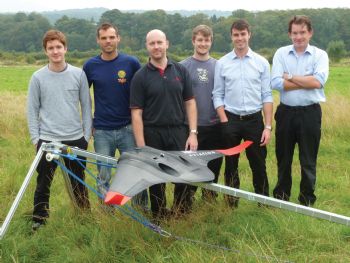
A team of engineering students from the Advanced Manufacturing Research Centre’s Design and Prototyping Group recently attended a US aerospace conference, where they delivered a presentation on a prototype of an Unmanned Aerial Vehicle (UAV) that they manufactured in March. It comprises nine parts, each of which was ‘3-D printed’ on a Stratasys Fortus machine.
That UAV was a glider with a low-cost airframe, weighing less than 2kg. However, at the Salt Lake City conference, the students unveiled a new UAV that is capable of powered flight, thanks to an electric ducted fan (EDF) engine.
Senior design engineer Garth Nicholson said that the team made the body of the UAV, complete with the twin engine ducts and complex internal features, as a single part.
They created a moveable ‘duck tail’ that uses the air leaving the engines for pitch control. In addition, they designed a launch catapult capable of propelling the UAV into the air with an acceleration up to three times that of gravity, achieving a launch speed of 12m/sec — or just under 30mph.
Having turned their 2kg glider into a 3.5kg powered UAV, capable of cruising at around 45mph, the team’s next challenge will be to replace the electric ducted fans with miniature gas-turbine engines and to double the wingspan to 3m.
The team is also looking at using novel methods of flight control to replace conventional elevons, using vapour polishing for the finishing of some printed components, including composite moulds, and developing batteries made from carbon composites that could act as part of the UAV’s structure.
Dr Nicholson said: “The project was a success on all levels — from team building, experience gained in structural and systems design and design for manufacture through to testing and validation of computational fluid dynamics. The aircraft was developed using both an incremental design philosophy and by trialling experimental manufacturing techniques in carbon-fibre production.”